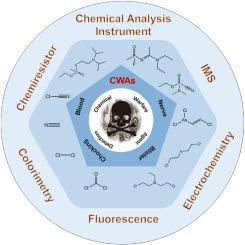化学战剂探测技术的研究现状
IF 12
1区 化学
Q1 CHEMISTRY, ANALYTICAL
引用次数: 0
摘要
化学战剂(CWAs)是一类剧毒化学品。由于毒性作用的不同,它们通常被分为不同的类别。尽管1993年的《禁止化学武器公约》禁止使用化学武器,但化学武器的易于制造和致命性使其仍然是一种威胁。因此,开发快速、准确、灵敏的CWAs检测技术至关重要。本文综述了CWAs的类型及其毒性机制,介绍了CWAs模拟物的用途,并详细讨论了近年来主流的CWAs检测技术,包括化学分析仪、离子迁移率光谱法(IMS)、电化学、荧光、比色法和化学电阻法。这些技术在灵敏度、选择性、便携性和检测速度等方面各有优缺点。同时,对近年来已投入商业应用的CWAs检测设备进行了列举和分析。最后,对CWAs检测技术在公共安全领域的应用前景进行了展望。本文章由计算机程序翻译,如有差异,请以英文原文为准。

Current status of research on chemical warfare agent detection technology
Chemical warfare agents (CWAs) are a class of highly toxic chemicals. They are often classified into different categories because of distinctions in their toxic effects. Although the Chemical Weapons Convention of 1993 banned the use of chemical weapons, the ease of manufacture and lethality of CWAs make them still a threat. Therefore, the development of rapid, accurate and sensitive detection techniques for CWAs is essential. This paper reviews the types of CWAs and their mechanisms of toxicity, introduces the use of CWAs mimics, and discusses in detail the mainstream CWAs detection techniques in recent years, including detection by Chemical Analysis Instrument, Ion Mobility Spectrometry (IMS), Electrochemistry, Fluorescence, Colorimetry, and Chemiresistor. Each of these technologies has its own advantages and disadvantages in terms of sensitivity, selectivity, portability and detection speed, etc. Meanwhile, this paper lists as well as analyzes the condition of CWAs detection equipment that have been put into commercial application in recent years. Finally, this paper provides an outlook on the future development of the application of CWAs detection technology in public safety.
求助全文
通过发布文献求助,成功后即可免费获取论文全文。
去求助
来源期刊

Trends in Analytical Chemistry
化学-分析化学
CiteScore
20.00
自引率
4.60%
发文量
257
审稿时长
3.4 months
期刊介绍:
TrAC publishes succinct and critical overviews of recent advancements in analytical chemistry, designed to assist analytical chemists and other users of analytical techniques. These reviews offer excellent, up-to-date, and timely coverage of various topics within analytical chemistry. Encompassing areas such as analytical instrumentation, biomedical analysis, biomolecular analysis, biosensors, chemical analysis, chemometrics, clinical chemistry, drug discovery, environmental analysis and monitoring, food analysis, forensic science, laboratory automation, materials science, metabolomics, pesticide-residue analysis, pharmaceutical analysis, proteomics, surface science, and water analysis and monitoring, these critical reviews provide comprehensive insights for practitioners in the field.
 求助内容:
求助内容: 应助结果提醒方式:
应助结果提醒方式:


